| Listing 1 - 10 of 11 | << page >> |
Sort by
|
Book
ISBN: 1282458000 1282936328 9786612936326 9786612458002 1400835399 9781400835393 9780691142920 0691142920 0691142939 9780691142937 Year: 2010 Publisher: Princeton, NJ
Abstract | Keywords | Export | Availability | Bookmark
 Loading...
Loading...Choose an application
- Reference Manager
- EndNote
- RefWorks (Direct export to RefWorks)
This book studies the intersection cohomology of the Shimura varieties associated to unitary groups of any rank over Q. In general, these varieties are not compact. The intersection cohomology of the Shimura variety associated to a reductive group G carries commuting actions of the absolute Galois group of the reflex field and of the group G(Af) of finite adelic points of G. The second action can be studied on the set of complex points of the Shimura variety. In this book, Sophie Morel identifies the Galois action--at good places--on the G(Af)-isotypical components of the cohomology. Morel uses the method developed by Langlands, Ihara, and Kottwitz, which is to compare the Grothendieck-Lefschetz fixed point formula and the Arthur-Selberg trace formula. The first problem, that of applying the fixed point formula to the intersection cohomology, is geometric in nature and is the object of the first chapter, which builds on Morel's previous work. She then turns to the group-theoretical problem of comparing these results with the trace formula, when G is a unitary group over Q. Applications are then given. In particular, the Galois representation on a G(Af)-isotypical component of the cohomology is identified at almost all places, modulo a non-explicit multiplicity. Morel also gives some results on base change from unitary groups to general linear groups.
Shimura varieties. --- Homology theory. --- Cohomology theory --- Contrahomology theory --- Algebraic topology --- Varieties, Shimura --- Arithmetical algebraic geometry --- Accuracy and precision. --- Adjoint. --- Algebraic closure. --- Archimedean property. --- Automorphism. --- Base change map. --- Base change. --- Calculation. --- Clay Mathematics Institute. --- Coefficient. --- Compact element. --- Compact space. --- Comparison theorem. --- Conjecture. --- Connected space. --- Connectedness. --- Constant term. --- Corollary. --- Duality (mathematics). --- Existential quantification. --- Exterior algebra. --- Finite field. --- Finite set. --- Fundamental lemma (Langlands program). --- Galois group. --- General linear group. --- Haar measure. --- Hecke algebra. --- Homomorphism. --- L-function. --- Logarithm. --- Mathematical induction. --- Mathematician. --- Maximal compact subgroup. --- Maximal ideal. --- Morphism. --- Neighbourhood (mathematics). --- Open set. --- Parabolic induction. --- Permutation. --- Prime number. --- Ramanujan–Petersson conjecture. --- Reductive group. --- Ring (mathematics). --- Scientific notation. --- Shimura variety. --- Simply connected space. --- Special case. --- Sub"ient. --- Subalgebra. --- Subgroup. --- Symplectic group. --- Theorem. --- Trace formula. --- Unitary group. --- Weyl group.
Book
ISBN: 0691138214 1400837111 0691138222 9780691138220 9781400837113 9780691138213 Year: 2008 Publisher: Princeton, NJ
Abstract | Keywords | Export | Availability | Bookmark
 Loading...
Loading...Choose an application
- Reference Manager
- EndNote
- RefWorks (Direct export to RefWorks)
In 1970, Phillip Griffiths envisioned that points at infinity could be added to the classifying space D of polarized Hodge structures. In this book, Kazuya Kato and Sampei Usui realize this dream by creating a logarithmic Hodge theory. They use the logarithmic structures begun by Fontaine-Illusie to revive nilpotent orbits as a logarithmic Hodge structure. The book focuses on two principal topics. First, Kato and Usui construct the fine moduli space of polarized logarithmic Hodge structures with additional structures. Even for a Hermitian symmetric domain D, the present theory is a refinement of the toroidal compactifications by Mumford et al. For general D, fine moduli spaces may have slits caused by Griffiths transversality at the boundary and be no longer locally compact. Second, Kato and Usui construct eight enlargements of D and describe their relations by a fundamental diagram, where four of these enlargements live in the Hodge theoretic area and the other four live in the algebra-group theoretic area. These two areas are connected by a continuous map given by the SL(2)-orbit theorem of Cattani-Kaplan-Schmid. This diagram is used for the construction in the first topic.
Hodge theory. --- Logarithms. --- Logs (Logarithms) --- Algebra --- Complex manifolds --- Differentiable manifolds --- Geometry, Algebraic --- Homology theory --- Algebraic group. --- Algebraic variety. --- Analytic manifold. --- Analytic space. --- Annulus (mathematics). --- Arithmetic group. --- Atlas (topology). --- Canonical map. --- Classifying space. --- Coefficient. --- Cohomology. --- Compactification (mathematics). --- Complex manifold. --- Complex number. --- Congruence subgroup. --- Conjecture. --- Connected component (graph theory). --- Continuous function. --- Convex cone. --- Degeneracy (mathematics). --- Diagram (category theory). --- Differential form. --- Direct image functor. --- Divisor. --- Elliptic curve. --- Equivalence class. --- Existential quantification. --- Finite set. --- Functor. --- Geometry. --- Hodge structure. --- Homeomorphism. --- Homomorphism. --- Inverse function. --- Iwasawa decomposition. --- Local homeomorphism. --- Local ring. --- Local system. --- Logarithmic. --- Maximal compact subgroup. --- Modular curve. --- Modular form. --- Moduli space. --- Monodromy. --- Monoid. --- Morphism. --- Natural number. --- Nilpotent orbit. --- Nilpotent. --- Open problem. --- Open set. --- P-adic Hodge theory. --- P-adic number. --- Point at infinity. --- Proper morphism. --- Pullback (category theory). --- Quotient space (topology). --- Rational number. --- Relative interior. --- Ring (mathematics). --- Ring homomorphism. --- Scientific notation. --- Set (mathematics). --- Sheaf (mathematics). --- Smooth morphism. --- Special case. --- Strong topology. --- Subgroup. --- Subobject. --- Subset. --- Surjective function. --- Tangent bundle. --- Taylor series. --- Theorem. --- Topological space. --- Topology. --- Transversality (mathematics). --- Two-dimensional space. --- Vector bundle. --- Vector space. --- Weak topology.
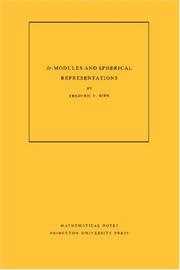
ISBN: 1400862078 9781400862078 0691025177 9780691608327 9780691025179 0691025177 0691608326 9780691608327 Year: 2014 Publisher: Princeton, NJ
Abstract | Keywords | Export | Availability | Bookmark
 Loading...
Loading...Choose an application
- Reference Manager
- EndNote
- RefWorks (Direct export to RefWorks)
The theory of D-modules deals with the algebraic aspects of differential equations. These are particularly interesting on homogeneous manifolds, since the infinitesimal action of a Lie algebra consists of differential operators. Hence, it is possible to attach geometric invariants, like the support and the characteristic variety, to representations of Lie groups. By considering D-modules on flag varieties, one obtains a simple classification of all irreducible admissible representations of reductive Lie groups. On the other hand, it is natural to study the representations realized by functions on pseudo-Riemannian symmetric spaces, i.e., spherical representations. The problem is then to describe the spherical representations among all irreducible ones, and to compute their multiplicities. This is the goal of this work, achieved fairly completely at least for the discrete series representations of reductive symmetric spaces. The book provides a general introduction to the theory of D-modules on flag varieties, and it describes spherical D-modules in terms of a cohomological formula. Using microlocalization of representations, the author derives a criterion for irreducibility. The relation between multiplicities and singularities is also discussed at length.Originally published in 1990.The Princeton Legacy Library uses the latest print-on-demand technology to again make available previously out-of-print books from the distinguished backlist of Princeton University Press. These editions preserve the original texts of these important books while presenting them in durable paperback and hardcover editions. The goal of the Princeton Legacy Library is to vastly increase access to the rich scholarly heritage found in the thousands of books published by Princeton University Press since its founding in 1905.
Differentiable manifolds. --- D-modules. --- Representations of groups. --- Lie groups. --- Groups, Lie --- Lie algebras --- Symmetric spaces --- Topological groups --- Group representation (Mathematics) --- Groups, Representation theory of --- Group theory --- Modules (Algebra) --- Differential manifolds --- Manifolds (Mathematics) --- Affine space. --- Algebraic cycle. --- Algebraic element. --- Analytic function. --- Annihilator (ring theory). --- Automorphism. --- Banach space. --- Base change. --- Big O notation. --- Bijection. --- Bilinear form. --- Borel subgroup. --- Cartan subalgebra. --- Cofibration. --- Cohomology. --- Commutative diagram. --- Commutative property. --- Commutator subgroup. --- Complexification (Lie group). --- Conjugacy class. --- Coproduct. --- Coset. --- Cotangent space. --- D-module. --- Derived category. --- Diagram (category theory). --- Differential operator. --- Dimension (vector space). --- Direct image functor. --- Discrete series representation. --- Disk (mathematics). --- Dot product. --- Double coset. --- Eigenfunction. --- Eigenvalues and eigenvectors. --- Endomorphism. --- Euler operator. --- Existential quantification. --- Fibration. --- Function space. --- Functor. --- G-module. --- Gelfand pair. --- Generic point. --- Hilbert space. --- Holomorphic function. --- Homomorphism. --- Hyperfunction. --- Ideal (ring theory). --- Infinitesimal character. --- Inner automorphism. --- Invertible sheaf. --- Irreducibility (mathematics). --- Irreducible representation. --- Levi decomposition. --- Lie algebra. --- Line bundle. --- Linear algebraic group. --- Linear space (geometry). --- Manifold. --- Maximal compact subgroup. --- Maximal torus. --- Metric space. --- Module (mathematics). --- Moment map. --- Morphism. --- Noetherian ring. --- Open set. --- Presheaf (category theory). --- Principal series representation. --- Projective line. --- Projective object. --- Projective space. --- Projective variety. --- Reductive group. --- Riemannian geometry. --- Riemann–Hilbert correspondence. --- Right inverse. --- Ring (mathematics). --- Root system. --- Satake diagram. --- Sheaf (mathematics). --- Sheaf of modules. --- Special case. --- Sphere. --- Square-integrable function. --- Sub"ient. --- Subalgebra. --- Subcategory. --- Subgroup. --- Summation. --- Surjective function. --- Symmetric space. --- Symplectic geometry. --- Tensor product. --- Theorem. --- Triangular matrix. --- Vector bundle. --- Volume form. --- Weyl group.
Book
ISBN: 1400882435 Year: 2016 Publisher: Princeton, NJ : Princeton University Press,
Abstract | Keywords | Export | Availability | Bookmark
 Loading...
Loading...Choose an application
- Reference Manager
- EndNote
- RefWorks (Direct export to RefWorks)
This book is concerned with two areas of mathematics, at first sight disjoint, and with some of the analogies and interactions between them. These areas are the theory of linear differential equations in one complex variable with polynomial coefficients, and the theory of one parameter families of exponential sums over finite fields. After reviewing some results from representation theory, the book discusses results about differential equations and their differential galois groups (G) and one-parameter families of exponential sums and their geometric monodromy groups (G). The final part of the book is devoted to comparison theorems relating G and G of suitably "corresponding" situations, which provide a systematic explanation of the remarkable "coincidences" found "by hand" in the hypergeometric case.
Exponential sums. --- Differential equations. --- Adjoint representation. --- Algebraic geometry. --- Algebraic integer. --- Algebraically closed field. --- Automorphism. --- Base change. --- Bernard Dwork. --- Big O notation. --- Bijection. --- Calculation. --- Characteristic polynomial. --- Codimension. --- Coefficient. --- Cohomology. --- Comparison theorem. --- Complex manifold. --- Conjugacy class. --- Connected component (graph theory). --- Convolution. --- Determinant. --- Diagram (category theory). --- Differential Galois theory. --- Differential equation. --- Dimension (vector space). --- Dimension. --- Direct sum. --- Divisor. --- Eigenvalues and eigenvectors. --- Endomorphism. --- Equation. --- Euler characteristic. --- Existential quantification. --- Exponential sum. --- Fiber bundle. --- Field of fractions. --- Finite field. --- Formal power series. --- Fourier transform. --- Fundamental group. --- Fundamental representation. --- Galois extension. --- Galois group. --- Gauss sum. --- Generic point. --- Group theory. --- Homomorphism. --- Hypergeometric function. --- Identity component. --- Identity element. --- Integer. --- Irreducibility (mathematics). --- Irreducible representation. --- Isogeny. --- Isomorphism class. --- L-function. --- Laurent polynomial. --- Lie algebra. --- Logarithm. --- Mathematical induction. --- Matrix coefficient. --- Maximal compact subgroup. --- Maximal torus. --- Mellin transform. --- Monic polynomial. --- Monodromy theorem. --- Monodromy. --- Monomial. --- Natural number. --- Normal subgroup. --- P-adic number. --- Permutation. --- Polynomial. --- Prime number. --- Pullback. --- Quotient group. --- Reductive group. --- Regular singular point. --- Representation theory. --- Ring homomorphism. --- Root of unity. --- Scientific notation. --- Set (mathematics). --- Sheaf (mathematics). --- Special case. --- Subcategory. --- Subgroup. --- Subring. --- Subset. --- Summation. --- Surjective function. --- Symmetric group. --- Tensor product. --- Theorem. --- Theory. --- Three-dimensional space (mathematics). --- Torsor (algebraic geometry). --- Trichotomy (mathematics). --- Unitarian trick. --- Unitary group. --- Variable (mathematics).
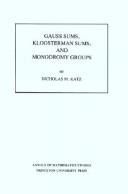
ISBN: 0691084335 0691084327 1400882125 Year: 1988 Volume: vol 116 Publisher: Princeton, N.J. Princeton University
Abstract | Keywords | Export | Availability | Bookmark
 Loading...
Loading...Choose an application
- Reference Manager
- EndNote
- RefWorks (Direct export to RefWorks)
The study of exponential sums over finite fields, begun by Gauss nearly two centuries ago, has been completely transformed in recent years by advances in algebraic geometry, culminating in Deligne's work on the Weil Conjectures. It now appears as a very attractive mixture of algebraic geometry, representation theory, and the sheaf-theoretic incarnations of such standard constructions of classical analysis as convolution and Fourier transform. The book is simultaneously an account of some of these ideas, techniques, and results, and an account of their application to concrete equidistribution questions concerning Kloosterman sums and Gauss sums.
Group theory --- Algebraic geometry --- Number theory --- 511.33 --- Analytical and multiplicative number theory. Asymptotics. Sieves etc. --- 511.33 Analytical and multiplicative number theory. Asymptotics. Sieves etc. --- Gaussian sums --- Homology theory --- Kloosterman sums --- Monodromy groups --- Kloostermann sums --- Sums, Kloosterman --- Sums, Kloostermann --- Exponential sums --- Cohomology theory --- Contrahomology theory --- Algebraic topology --- Gauss sums --- Sums, Gaussian --- Analytical and multiplicative number theory. Asymptotics. Sieves etc --- Gaussian sums. --- Kloosterman sums. --- Homology theory. --- Monodromy groups. --- Number theory. --- Nombres, Théorie des. --- Exponential sums. --- Sommes exponentielles. --- Arithmetic --- Arithmétique --- Geometry, Algebraic. --- Géométrie algébrique --- Abelian category. --- Absolute Galois group. --- Absolute value. --- Additive group. --- Adjoint representation. --- Affine variety. --- Algebraic group. --- Automorphic form. --- Automorphism. --- Big O notation. --- Cartan subalgebra. --- Characteristic polynomial. --- Classification theorem. --- Coefficient. --- Cohomology. --- Cokernel. --- Combination. --- Commutator. --- Compactification (mathematics). --- Complex Lie group. --- Complex number. --- Conjugacy class. --- Continuous function. --- Convolution theorem. --- Convolution. --- Determinant. --- Diagonal matrix. --- Dimension (vector space). --- Direct sum. --- Dual basis. --- Eigenvalues and eigenvectors. --- Empty set. --- Endomorphism. --- Equidistribution theorem. --- Estimation. --- Exactness. --- Existential quantification. --- Exponential sum. --- Exterior algebra. --- Faithful representation. --- Finite field. --- Finite group. --- Four-dimensional space. --- Frobenius endomorphism. --- Fundamental group. --- Fundamental representation. --- Galois group. --- Gauss sum. --- Homomorphism. --- Integer. --- Irreducibility (mathematics). --- Isomorphism class. --- Kloosterman sum. --- L-function. --- Leray spectral sequence. --- Lie algebra. --- Lie theory. --- Maximal compact subgroup. --- Method of moments (statistics). --- Monodromy theorem. --- Monodromy. --- Morphism. --- Multiplicative group. --- Natural number. --- Nilpotent. --- Open problem. --- P-group. --- Pairing. --- Parameter space. --- Parameter. --- Partially ordered set. --- Perfect field. --- Point at infinity. --- Polynomial ring. --- Prime number. --- Quotient group. --- Representation ring. --- Representation theory. --- Residue field. --- Riemann hypothesis. --- Root of unity. --- Sheaf (mathematics). --- Simple Lie group. --- Skew-symmetric matrix. --- Smooth morphism. --- Special case. --- Spin representation. --- Subgroup. --- Support (mathematics). --- Symmetric matrix. --- Symplectic group. --- Symplectic vector space. --- Tensor product. --- Theorem. --- Trace (linear algebra). --- Trivial representation. --- Variable (mathematics). --- Weil conjectures. --- Weyl character formula. --- Zariski topology.
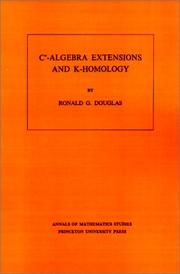
ISBN: 0691082650 0691082669 1400881463 Year: 1980 Publisher: Princeton, N.J.
Abstract | Keywords | Export | Availability | Bookmark
 Loading...
Loading...Choose an application
- Reference Manager
- EndNote
- RefWorks (Direct export to RefWorks)
Recent developments in diverse areas of mathematics suggest the study of a certain class of extensions of C*-algebras. Here, Ronald Douglas uses methods from homological algebra to study this collection of extensions. He first shows that equivalence classes of the extensions of the compact metrizable space X form an abelian group Ext (X). Second, he shows that the correspondence X ⃗ Ext (X) defines a homotopy invariant covariant functor which can then be used to define a generalized homology theory. Establishing the periodicity of order two, the author shows, following Atiyah, that a concrete realization of K-homology is obtained.
Analytical spaces --- 517.986 --- Topological algebras. Theory of infinite-dimensional representations --- Algebra, Homological. --- C*-algebras. --- K-theory. --- 517.986 Topological algebras. Theory of infinite-dimensional representations --- Algebra, Homological --- C*-algebras --- K-theory --- Algebraic topology --- Homology theory --- Algebras, C star --- Algebras, W star --- C star algebras --- W star algebras --- W*-algebras --- Banach algebras --- Homological algebra --- Algebra, Abstract --- K-théorie. --- Homologie. --- Addition. --- Affine transformation. --- Algebraic topology. --- Atiyah–Singer index theorem. --- Automorphism. --- Banach algebra. --- Bijection. --- Boundary value problem. --- Bundle map. --- C*-algebra. --- Calculation. --- Cardinal number. --- Category of abelian groups. --- Characteristic class. --- Chern class. --- Clifford algebra. --- Coefficient. --- Cohomology. --- Compact operator. --- Completely positive map. --- Contact geometry. --- Continuous function. --- Corollary. --- Diagram (category theory). --- Diffeomorphism. --- Differentiable manifold. --- Differential operator. --- Dimension (vector space). --- Dimension function. --- Dimension. --- Direct integral. --- Direct proof. --- Eigenvalues and eigenvectors. --- Equivalence class. --- Equivalence relation. --- Essential spectrum. --- Euler class. --- Exact sequence. --- Existential quantification. --- Fiber bundle. --- Finite group. --- Fredholm operator. --- Fredholm. --- Free abelian group. --- Fundamental class. --- Fundamental group. --- Hardy space. --- Hermann Weyl. --- Hilbert space. --- Homological algebra. --- Homology (mathematics). --- Homomorphism. --- Homotopy. --- Ideal (ring theory). --- Inner automorphism. --- Irreducible representation. --- K-group. --- Lebesgue space. --- Locally compact group. --- Maximal compact subgroup. --- Michael Atiyah. --- Monomorphism. --- Morphism. --- Natural number. --- Natural transformation. --- Normal operator. --- Operator algebra. --- Operator norm. --- Operator theory. --- Orthogonal group. --- Pairing. --- Piecewise linear manifold. --- Polynomial. --- Pontryagin class. --- Positive and negative parts. --- Positive map. --- Pseudo-differential operator. --- Quaternion. --- Quotient algebra. --- Self-adjoint operator. --- Self-adjoint. --- Simply connected space. --- Smooth structure. --- Special case. --- Stein manifold. --- Strong topology. --- Subalgebra. --- Subgroup. --- Subset. --- Summation. --- Tangent bundle. --- Theorem. --- Todd class. --- Topology. --- Torsion subgroup. --- Unitary operator. --- Universal coefficient theorem. --- Variable (mathematics). --- Von Neumann algebra. --- Homology theory. --- Homologie --- K-théorie --- C etoile-algebres
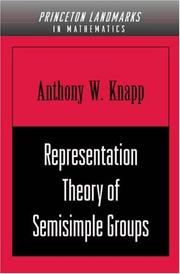
ISBN: 0691090890 9780691090894 0691084017 1400883970 9780691084015 Year: 1986 Volume: 36 Publisher: Princeton, N.J.
Abstract | Keywords | Export | Availability | Bookmark
 Loading...
Loading...Choose an application
- Reference Manager
- EndNote
- RefWorks (Direct export to RefWorks)
In this classic work, Anthony W. Knapp offers a survey of representation theory of semisimple Lie groups in a way that reflects the spirit of the subject and corresponds to the natural learning process. This book is a model of exposition and an invaluable resource for both graduate students and researchers. Although theorems are always stated precisely, many illustrative examples or classes of examples are given. To support this unique approach, the author includes for the reader a useful 300-item bibliography and an extensive section of notes.
Semisimple Lie groups. --- Representations of groups. --- Groupes de Lie semi-simples --- Représentations de groupes --- Semisimple Lie groups --- Representations of groups --- Semi-simple Lie groups --- Lie groups --- Group representation (Mathematics) --- Groups, Representation theory of --- Group theory --- Représentations de groupes --- 512.547 --- 512.547 Linear representations of abstract groups. Group characters --- Linear representations of abstract groups. Group characters --- Abelian group. --- Admissible representation. --- Algebra homomorphism. --- Analytic function. --- Analytic proof. --- Associative algebra. --- Asymptotic expansion. --- Automorphic form. --- Automorphism. --- Bounded operator. --- Bounded set (topological vector space). --- Cartan subalgebra. --- Cartan subgroup. --- Category theory. --- Characterization (mathematics). --- Classification theorem. --- Cohomology. --- Complex conjugate representation. --- Complexification (Lie group). --- Complexification. --- Conjugate transpose. --- Continuous function (set theory). --- Degenerate bilinear form. --- Diagram (category theory). --- Dimension (vector space). --- Dirac operator. --- Discrete series representation. --- Distribution (mathematics). --- Eigenfunction. --- Eigenvalues and eigenvectors. --- Existence theorem. --- Explicit formulae (L-function). --- Fourier inversion theorem. --- General linear group. --- Group homomorphism. --- Haar measure. --- Heine–Borel theorem. --- Hermitian matrix. --- Hilbert space. --- Holomorphic function. --- Hyperbolic function. --- Identity (mathematics). --- Induced representation. --- Infinitesimal character. --- Integration by parts. --- Invariant subspace. --- Invertible matrix. --- Irreducible representation. --- Jacobian matrix and determinant. --- K-finite. --- Levi decomposition. --- Lie algebra. --- Locally integrable function. --- Mathematical induction. --- Matrix coefficient. --- Matrix group. --- Maximal compact subgroup. --- Meromorphic function. --- Metric space. --- Nilpotent Lie algebra. --- Norm (mathematics). --- Parity (mathematics). --- Plancherel theorem. --- Projection (linear algebra). --- Quantifier (logic). --- Reductive group. --- Representation of a Lie group. --- Representation theory. --- Schwartz space. --- Semisimple Lie algebra. --- Set (mathematics). --- Sign (mathematics). --- Solvable Lie algebra. --- Special case. --- Special linear group. --- Special unitary group. --- Subgroup. --- Summation. --- Support (mathematics). --- Symmetric algebra. --- Symmetrization. --- Symplectic group. --- Tensor algebra. --- Tensor product. --- Theorem. --- Topological group. --- Topological space. --- Topological vector space. --- Unitary group. --- Unitary matrix. --- Unitary representation. --- Universal enveloping algebra. --- Variable (mathematics). --- Vector bundle. --- Weight (representation theory). --- Weyl character formula. --- Weyl group. --- Weyl's theorem. --- ZPP (complexity). --- Zorn's lemma.
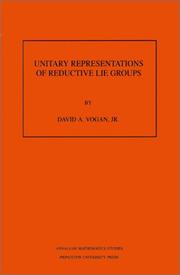
ISBN: 0691084815 0691084823 1400882389 9780691084824 9780691084817 Year: 1987 Publisher: Princeton Princeton University Press
Abstract | Keywords | Export | Availability | Bookmark
 Loading...
Loading...Choose an application
- Reference Manager
- EndNote
- RefWorks (Direct export to RefWorks)
This book is an expanded version of the Hermann Weyl Lectures given at the Institute for Advanced Study in January 1986. It outlines some of what is now known about irreducible unitary representations of real reductive groups, providing fairly complete definitions and references, and sketches (at least) of most proofs. The first half of the book is devoted to the three more or less understood constructions of such representations: parabolic induction, complementary series, and cohomological parabolic induction. This culminates in the description of all irreducible unitary representation of the general linear groups. For other groups, one expects to need a new construction, giving "unipotent representations." The latter half of the book explains the evidence for that expectation and suggests a partial definition of unipotent representations.
Lie groups --- Representations of Lie groups --- Lie groups. --- Representations of Lie groups. --- 512.81 --- Groups, Lie --- Lie algebras --- Symmetric spaces --- Topological groups --- 512.81 Lie groups --- Abelian group. --- Adjoint representation. --- Annihilator (ring theory). --- Atiyah–Singer index theorem. --- Automorphic form. --- Automorphism. --- Cartan subgroup. --- Circle group. --- Class function (algebra). --- Classification theorem. --- Cohomology. --- Commutator subgroup. --- Complete metric space. --- Complex manifold. --- Conjugacy class. --- Cotangent space. --- Dimension (vector space). --- Discrete series representation. --- Dixmier conjecture. --- Dolbeault cohomology. --- Duality (mathematics). --- Eigenvalues and eigenvectors. --- Exponential map (Lie theory). --- Exponential map (Riemannian geometry). --- Exterior algebra. --- Function space. --- Group homomorphism. --- Harmonic analysis. --- Hecke algebra. --- Hilbert space. --- Hodge theory. --- Holomorphic function. --- Holomorphic vector bundle. --- Homogeneous space. --- Homomorphism. --- Induced representation. --- Infinitesimal character. --- Inner automorphism. --- Invariant subspace. --- Irreducibility (mathematics). --- Irreducible representation. --- Isometry group. --- Isometry. --- K-finite. --- Kazhdan–Lusztig polynomial. --- Langlands decomposition. --- Lie algebra cohomology. --- Lie algebra representation. --- Lie algebra. --- Lie group action. --- Lie group. --- Mathematical induction. --- Maximal compact subgroup. --- Measure (mathematics). --- Minkowski space. --- Nilpotent group. --- Orbit method. --- Orthogonal group. --- Parabolic induction. --- Principal homogeneous space. --- Principal series representation. --- Projective space. --- Pseudo-Riemannian manifold. --- Pullback (category theory). --- Ramanujan–Petersson conjecture. --- Reductive group. --- Regularity theorem. --- Representation of a Lie group. --- Representation theorem. --- Representation theory. --- Riemann sphere. --- Riemannian manifold. --- Schwartz space. --- Semisimple Lie algebra. --- Sheaf (mathematics). --- Sign (mathematics). --- Special case. --- Spectral theory. --- Sub"ient. --- Subgroup. --- Support (mathematics). --- Symplectic geometry. --- Symplectic group. --- Symplectic vector space. --- Tangent space. --- Tautological bundle. --- Theorem. --- Topological group. --- Topological space. --- Trivial representation. --- Unitary group. --- Unitary matrix. --- Unitary representation. --- Universal enveloping algebra. --- Vector bundle. --- Weyl algebra. --- Weyl character formula. --- Weyl group. --- Zariski's main theorem. --- Zonal spherical function. --- Représentations de groupes de Lie --- Groupes de lie --- Representation des groupes de lie
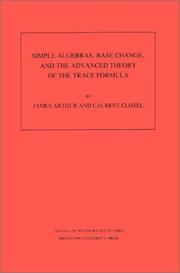
ISBN: 0691085188 069108517X 1400882400 Year: 1989 Volume: vol 120 Publisher: Princeton University Press
Abstract | Keywords | Export | Availability | Bookmark
 Loading...
Loading...Choose an application
- Reference Manager
- EndNote
- RefWorks (Direct export to RefWorks)
A general principle, discovered by Robert Langlands and named by him the "functoriality principle," predicts relations between automorphic forms on arithmetic subgroups of different reductive groups. Langlands functoriality relates the eigenvalues of Hecke operators acting on the automorphic forms on two groups (or the local factors of the "automorphic representations" generated by them). In the few instances where such relations have been probed, they have led to deep arithmetic consequences. This book studies one of the simplest general problems in the theory, that of relating automorphic forms on arithmetic subgroups of GL(n,E) and GL(n,F) when E/F is a cyclic extension of number fields. (This is known as the base change problem for GL(n).) The problem is attacked and solved by means of the trace formula. The book relies on deep and technical results obtained by several authors during the last twenty years. It could not serve as an introduction to them, but, by giving complete references to the published literature, the authors have made the work useful to a reader who does not know all the aspects of the theory of automorphic forms.
511.33 --- Analytical and multiplicative number theory. Asymptotics. Sieves etc. --- 511.33 Analytical and multiplicative number theory. Asymptotics. Sieves etc. --- Automorfe vormen --- Automorphic forms --- Formes automorphes --- Representation des groupes --- Representations of groups --- Trace formulas --- Vertegenwoordiging van groepen --- Formulas, Trace --- Discontinuous groups --- Group representation (Mathematics) --- Groups, Representation theory of --- Group theory --- Automorphic functions --- Forms (Mathematics) --- Analytical and multiplicative number theory. Asymptotics. Sieves etc --- Representations of groups. --- Trace formulas. --- Automorphic forms. --- 0E. --- Addition. --- Admissible representation. --- Algebraic group. --- Algebraic number field. --- Approximation. --- Archimedean property. --- Automorphic form. --- Automorphism. --- Base change. --- Big O notation. --- Binomial coefficient. --- Canonical map. --- Cartan subalgebra. --- Cartan subgroup. --- Central simple algebra. --- Characteristic polynomial. --- Closure (mathematics). --- Combination. --- Computation. --- Conjecture. --- Conjugacy class. --- Connected component (graph theory). --- Continuous function. --- Contradiction. --- Corollary. --- Counting. --- Coxeter element. --- Cusp form. --- Cyclic permutation. --- Dense set. --- Density theorem. --- Determinant. --- Diagram (category theory). --- Discrete series representation. --- Discrete spectrum. --- Division algebra. --- Eigenvalues and eigenvectors. --- Eisenstein series. --- Exact sequence. --- Existential quantification. --- Field extension. --- Finite group. --- Finite set. --- Fourier transform. --- Functor. --- Fundamental lemma (Langlands program). --- Galois extension. --- Galois group. --- Global field. --- Grothendieck group. --- Group representation. --- Haar measure. --- Harmonic analysis. --- Hecke algebra. --- Hilbert's Theorem 90. --- Identity component. --- Induced representation. --- Infinite product. --- Infinitesimal character. --- Invariant measure. --- Irreducibility (mathematics). --- Irreducible representation. --- L-function. --- Langlands classification. --- Laurent series. --- Lie algebra. --- Lie group. --- Linear algebraic group. --- Local field. --- Mathematical induction. --- Maximal compact subgroup. --- Multiplicative group. --- Nilpotent group. --- Orbital integral. --- P-adic number. --- Paley–Wiener theorem. --- Parameter. --- Parametrization. --- Permutation. --- Poisson summation formula. --- Real number. --- Reciprocal lattice. --- Reductive group. --- Root of unity. --- Scientific notation. --- Semidirect product. --- Special case. --- Spherical harmonics. --- Subgroup. --- Subset. --- Summation. --- Support (mathematics). --- Tensor product. --- Theorem. --- Trace formula. --- Unitary representation. --- Weil group. --- Weyl group. --- Zero of a function.
Book
ISBN: 0691141843 0691141851 9786612303807 1282303805 1400831067 9781400831067 9781282303805 9780691141848 9780691141855 Year: 2009 Volume: 172 Publisher: Princeton, NJ
Abstract | Keywords | Export | Availability | Bookmark
 Loading...
Loading...Choose an application
- Reference Manager
- EndNote
- RefWorks (Direct export to RefWorks)
The results established in this book constitute a new departure in ergodic theory and a significant expansion of its scope. Traditional ergodic theorems focused on amenable groups, and relied on the existence of an asymptotically invariant sequence in the group, the resulting maximal inequalities based on covering arguments, and the transference principle. Here, Alexander Gorodnik and Amos Nevo develop a systematic general approach to the proof of ergodic theorems for a large class of non-amenable locally compact groups and their lattice subgroups. Simple general conditions on the spectral theory of the group and the regularity of the averaging sets are formulated, which suffice to guarantee convergence to the ergodic mean. In particular, this approach gives a complete solution to the problem of establishing mean and pointwise ergodic theorems for the natural averages on semisimple algebraic groups and on their discrete lattice subgroups. Furthermore, an explicit quantitative rate of convergence to the ergodic mean is established in many cases. The topic of this volume lies at the intersection of several mathematical fields of fundamental importance. These include ergodic theory and dynamics of non-amenable groups, harmonic analysis on semisimple algebraic groups and their homogeneous spaces, quantitative non-Euclidean lattice point counting problems and their application to number theory, as well as equidistribution and non-commutative Diophantine approximation. Many examples and applications are provided in the text, demonstrating the usefulness of the results established.
Dynamics. --- Ergodic theory. --- Harmonic analysis. --- Lattice theory. --- Lie groups. --- Ergodic theory --- Lie groups --- Lattice theory --- Harmonic analysis --- Dynamics --- Calculus --- Mathematics --- Physical Sciences & Mathematics --- Dynamical systems --- Kinetics --- Analysis (Mathematics) --- Functions, Potential --- Potential functions --- Lattices (Mathematics) --- Space lattice (Mathematics) --- Structural analysis (Mathematics) --- Groups, Lie --- Ergodic transformations --- Mechanics, Analytic --- Force and energy --- Mechanics --- Physics --- Statics --- Banach algebras --- Mathematical analysis --- Bessel functions --- Fourier series --- Harmonic functions --- Time-series analysis --- Algebra, Abstract --- Algebra, Boolean --- Group theory --- Set theory --- Topology --- Transformations (Mathematics) --- Crystallography, Mathematical --- Lie algebras --- Symmetric spaces --- Topological groups --- Continuous groups --- Mathematical physics --- Measure theory --- Absolute continuity. --- Algebraic group. --- Amenable group. --- Asymptote. --- Asymptotic analysis. --- Asymptotic expansion. --- Automorphism. --- Borel set. --- Bounded function. --- Bounded operator. --- Bounded set (topological vector space). --- Congruence subgroup. --- Continuous function. --- Convergence of random variables. --- Convolution. --- Coset. --- Counting problem (complexity). --- Counting. --- Differentiable function. --- Dimension (vector space). --- Diophantine approximation. --- Direct integral. --- Direct product. --- Discrete group. --- Embedding. --- Equidistribution theorem. --- Ergodicity. --- Estimation. --- Explicit formulae (L-function). --- Family of sets. --- Haar measure. --- Hilbert space. --- Hyperbolic space. --- Induced representation. --- Infimum and supremum. --- Initial condition. --- Interpolation theorem. --- Invariance principle (linguistics). --- Invariant measure. --- Irreducible representation. --- Isometry group. --- Iwasawa group. --- Lattice (group). --- Lie algebra. --- Linear algebraic group. --- Linear space (geometry). --- Lipschitz continuity. --- Mass distribution. --- Mathematical induction. --- Maximal compact subgroup. --- Maximal ergodic theorem. --- Measure (mathematics). --- Mellin transform. --- Metric space. --- Monotonic function. --- Neighbourhood (mathematics). --- Normal subgroup. --- Number theory. --- One-parameter group. --- Operator norm. --- Orthogonal complement. --- P-adic number. --- Parametrization. --- Parity (mathematics). --- Pointwise convergence. --- Pointwise. --- Principal homogeneous space. --- Principal series representation. --- Probability measure. --- Probability space. --- Probability. --- Rate of convergence. --- Regular representation. --- Representation theory. --- Resolution of singularities. --- Sobolev space. --- Special case. --- Spectral gap. --- Spectral method. --- Spectral theory. --- Square (algebra). --- Subgroup. --- Subsequence. --- Subset. --- Symmetric space. --- Tensor algebra. --- Tensor product. --- Theorem. --- Transfer principle. --- Unit sphere. --- Unit vector. --- Unitary group. --- Unitary representation. --- Upper and lower bounds. --- Variable (mathematics). --- Vector group. --- Vector space. --- Volume form. --- Word metric.
| Listing 1 - 10 of 11 | << page >> |
Sort by
|

 Search
Search Feedback
Feedback About UniCat
About UniCat  Help
Help News
News